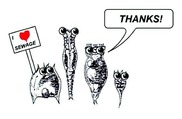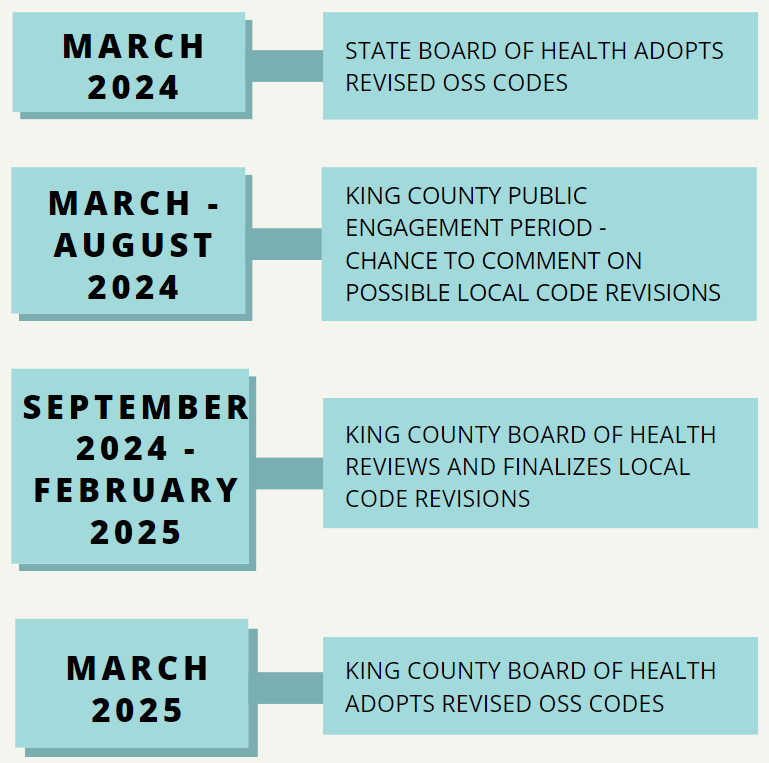|
Happy New Year! We hope you and your loved ones had a wonderful holiday season. We at the King County On-site Sewage System (OSS) Program are looking forward to another busy year. One of our top priorities is revising the King County OSS codes. This March, we expect the Washington State Board of Health to adopt revised OSS codes. After that, King County will have 12 months to adopt revised codes that comply with the state's changes. That's why we're launching this newsletter - to keep you informed of what's happening and how you can be involved.
Each month, we'll share the latest developments and key OSS information. Today, we're covering the basics of OSS and OSS codes. Next month, we'll dig deeper into the life cycle of OSS and what you can expect during the county's code revision process. Right now, we anticipate having a public engagement period from March to August where you'll be able to give feedback on local OSS codes and potential changes.
On that note - the State Board of Health is holding a public meeting tomorrow, Jan. 10, at 1:30 p.m. They'll be discussing proposed changes to the state OSS codes, and there's a public comment opportunity. You can learn more on the State Board of Health's website.
If you have any questions, please don't hesitate to reach out. We look forward to working with you this year!
Sincerely,
Lynn Schneider, RS | OSS Program Supervisor
206.477.2124 | lynn.schneider@kingcounty.gov
Lara Brezina, RS | Interim OSS Operation & Maintenance Program Supervisor
206.477.1764 | lbrezina@kingcounty.gov


OSS treat sewage using natural bacteria
A septic system (also known as an OSS, or On-site Sewage System) collects the sewage coming out of a house that doesn’t have sewer. The OSS treats the sewage and spreads the clean water back into the environment, recharging the groundwater. Bacteria in your OSS and in the soil play the biggest role in converting wastewater to clean water. Bacteria eat up the organic matter and kill some of the germs.
|
There are two steps to on-site wastewater treatment: waste separation and filtering through soil. In the first step, sewage moves through a septic tank. Lighter particles and heavier particles separate, leaving behind a clear layer of sewage. In the second step, sewage moves into the drainfield, where bacteria use oxygen to eat up the organic matter. The soil also filters bad things out as the wastewater moves through it.
Sometimes sewage needs more treatment before it goes into the soil. In these cases, OSS have pumps, air compressors, filters, and other complex equipment to help remove more germs and organic matter.
Don’t forget the back-up
OSS don’t last forever. In the same way that you need to replace your roof, OSS need to be replaced every 30-50 years. When an OSS is installed, the designer chooses a reserve drainfield area. This area needs to be protected so that a new system can be installed when the existing one fails.
An OSS is like a car - maintenance is key
It's easy to forget about an OSS as it sits under your yard and does the hard work of treating your sewage. But just like cars, they need to have regular tune-ups to make sure they are working properly. Check out these tips and tricks for how to keep an OSS functioning well.

Background - why we have OSS regulations
OSS (On-site Sewage Systems, also known as septic systems) don’t just get rid of our wastewater; they treat wastewater to make clean water that goes into the environment. In order to do this, OSS have to meet specific design, installation, and maintenance requirements. These requirements are specified in codes and regulations.
The State of Washington sets minimum standards for OSS codes. Many counties choose to adopt more stringent standards because they have specific issues that need more stringent regulations. King County Board of Health Title 13 is the code that regulates OSS in King County.
OSS regulations protect public health, the environment, and property values by minimizing exposure to raw sewage. When OSS fail, or if they don't work properly, sewage can back up into our houses. It can flow into our yards, travel onto streets and sidewalks, and work its way into local streams and beaches. If partially treated sewage gets into groundwater, it can make people sick when they drink water from a well. We rely on OSS that work well to make sure that everyone in our community is healthy.
OSS regulations also support the economy and food safety - for instance, in some areas of our county, there are shellfish harvesting beds next to properties with OSS. These shellfish are harvested and served raw in restaurants all over the world. Good OSS regulations help ensure it's safe to eat shellfish harvested in Washington!
Updating regulations for the state and county
In late 2017, the Washington State Department of Health conducted a review of Chapter 246-272A WAC, On-site Sewage Systems. They evaluated the chapter's overall effectiveness and which areas needed revision. Based on the review, the State Department of Health concluded the key issues that need to be updated are:
- definitions
- local management plans
- time of sale inspections
- maintenance provider certifications
- a variety of specific design criteria
You can learn more about this process on the state's On-site Sewage System Rule Revision website.
The State is in the final stages of the code update process. The Washington State Board of Health is holding a public hearing on the proposed rules on January 10, 2024, at 1:30 p.m. Then the Board will vote on whether to adopt the revised code. After the codes go into effect, King County will have twelve months to update our local OSS code to be at least as stringent as the state code. In addition to any required changes from the state, we will evaluate our code to find ways to improve it by making it more effective and reducing barriers.
During the first half of 2024, we will work with the King County On-site Sewage System Technical Advisory Committee and many other interested parties. We will develop proposed code revisions to bring to the King County Board of Health. The Board is responsible for evaluating the proposed revisions and voting for which ones will be adopted.
We welcome you to participate in the process by joining us for meetings, emailing us, or calling us. We will use this newsletter to keep you informed of the various opportunities you will have to provide input into the King County code revision process.
Each month, we'll define key terms to know about septic systems.
|
Sewage
|
Water carrying human wastes, including kitchen, bath, and laundry wastes from residences, buildings, industrial establishments, or other places.
|
|
Septic System/On-site Sewage Systems (OSS)
|
A system of components, located on or nearby the property it serves, that conveys, stores, treats, and/or provides underground treatment and dispersal of sewage. It consists of a collection system (pipes), a treatment component (septic tank), and a soil dispersal component (drainfield).
|
|
Septic Tank
|
A buried, watertight tank designed and constructed to receive and partially treat raw sewage. The tank separates settleable (heavy) and floatable (light) solids suspended in the sewage and discharges the liquid sewage to a drainfield for further treatment.
|
|
Drainfield
|
Soil area into which pretreated sewage is discharged through distribution piping. The soil accepts, treats, and disperses sewage as it seeps through the soil, ultimately discharging to groundwater.
|
|
Reserve Drainfield
|
An area of land approved for the installation of a replacement OSS once the current one fails. The area must be protected and maintained.
|
|
Failure
|
When an OSS doesn't sufficiently treat sewage or when there's a potential for contact between sewage and the public. An example of this is sewage on the surface of the ground. Failures are a threat to public health.
|
|
Septic System Designer
|
A person who matches site and soil characteristics with appropriate on-site sewage technology. This term applies to both on-site sewage treatment system designers licensed under chapter 18.210 RCW and professional engineers licensed under chapter 18.43 RCW.
|
Key steps in the code revision process:

|